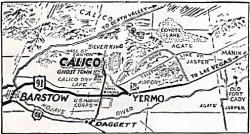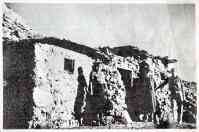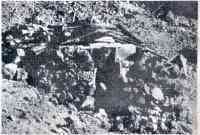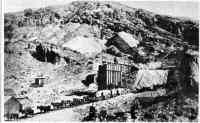
Established 1882 by Vincent & Overshiner
Published at Calico Silver Camp
San Bernardino County, California
EDITED BY HAROLD AND LUCILE WEIGHT
Copyright by THE CALICO PRESS
Our Colors . . . .
(Prom Calico Print, Vol. I, No.1, July 12, 1882)
According to that oft-repeated anecdote a painter, who was just mounting the first rung in the ladder of artistic fame, attempted to depict on canvas an equine quadruped, and apprehensive that there might be a doubt in the minds of some as to the species of animal it was intended to represent, wrote below in bold letters the inscription, "This is a Horse."
Apprehensive that the casual observer of the heading of this sheet might think that it was a piece of common fabric sold at fourteen yards for a dollar, which blushing brides are so loath to clothe themselves with after being arrayed in orange blossoms, silk and satin, during a brief blissful honeymoon-we simply say, "This is a Newspaper." It is not an organ. It will not be used to grind out some favorite tune or hobby regardless of the effect it may "have upon the minds of our readers.
Fifty-two yards of this CALICO PRINT will be sold to each subscriber annually for four dollars, and we can assure you that all who make such an investment will find it a profitable one. We will assure you its colors will never fade so long as we receive a generous supply of the “color" that is being taken daily in abundance from some of the many rich mines of this district.
(Note: This subscription offer expired prior to 1890)
Yung Hen Was a Tough Old Rooster
By Herman F. Mellen
In the beginning Calico prided itself on being an anti-Chinese camp. But it proved almost impossible to get any but Chinese cooks, so anyone who maintained a mine boarding house or restaurant in the Calicos just about had to hire Chinese help.
Yung Hen-naturally called Young Hen-started as a cook in the Snowbird mine in Mule Canyon. He was perhaps 50, though it was difficult to judge his age. He-in fact all of them – wore a long queue. And though they wore levis, they also wore their traditional Chinese blouses. I believe he was Cantonese.
After cooking at several mines, Yung Hen decided to go into business for himself by starting a restaurant in Calico. A mass meeting was held to prevent it at which a big Cornish miner arose and gave his solution to the problem: "I tell you, boys, if - we just keep the first one out we'll never have any trouble with those that come afterward."
The mass meeting didn't stop Young Hen, nor did attempts to frighten .him away. Once a group took him out and actually had the rope around his neck, threatening to hang him if he did not leave. He said calmly, "All right, go ahead. Plenty more Chinamen where I come from."
In time Yung Hen had three or four boarding houses. He spent most of his time in Calico, putting his cousins in the others as managers. In 1885 he bought out the family running the boarding house at the Occidental mine, where I was carpenter. I was loaned to him. He told me what he wanted done, building tables and benches, and moving partitions in adding another room to the building. Then he left me with his two cousins, who were I laughing and skylarking all day long.
One day these boys wanted me to eat with them. They had cooked a dish which they seemed to consider a great delicacy – with a foundation of dried abalones about the size and toughness of rubber boot heels and fully as black. After these had boiled a couple of hours, Chinese cabbage and some sort of small fish, both of which smelled to high heaven, were added and all were boiled another hour. Twenty minutes before serving, two-inch cubes of fat fresh pork were added and cooked just long enough to become nearly transparent. The boys insisted that the stew was velly nice, but I felt I must decline it.
A couple of days after Christmas 1884, a young Irishman known as Scotty, who had been celebrating by imbibing largely of "tarantula juice,", decided to complete the celebration with a turkey dinner. So he hied himself to Yung Hen's Calico restaurant and ordered turkey and fixin's. The two young Chinese boys – cousins or nephews of Yung Hen – set before him all their remaining turkey, largely, scraps and bones.
This so highly offended Scotty that he forgot the spirit of Christmas, threw the food at the boy who waited on him, upset the table and began smashing dishes and furniture. The two Chinese boys grappled with him, trying to put him outside, and in the melee Scotty lost one shoe, most of one pants leg and his shirt.
To the glory of old Ireland, he was holding his own until one of the boys rushed into the kitchen, returning with a bucket of almostboiling water in one hand and a long-handled dipper in the other. A few dippers of water placed where they did the most good and the restaurant and whole camp were too small for friend Scotty. He made what the boys facetiously called a straight shirttail for the mine where he was employed and spent several days nursing various scalded places about his person, the while he cursed the Chinese people in general and the relatives of Yung Hen in particular.
He didn't receive much sympathy, however, as by then Yung Hen stood well in the camp. A goodly number of prospectors had been grubstaked by him and many a man had eaten on credit with him until he could get a job.
And by that time they had a saying that though he might be a young hen in name he was some tough old rooster by nature.
“Cousin Jacks” in Calico
By Herman F. Mellen
Most of the small piled rock and semi-dugout dwellings near the mines at Calico were built by Cornish miners, known as "Cousin Jacks," possibly because about every third person among them was named John and called Jack and because so many of them seemed to be related. They had a great feeling for ties of blood, and when they became prosperous, they would send for their relatives.
I first became acquainted with them at the Garfield mine in Odessa canyon in 1884. About 50 per cent of the working force there, including the mine foreman, was Cornish. They spoke a patois all their own; a mixture of English, Welsh and probably Gaelic, with a few words brought down from the ancient Picts. Their sentence structure was unique which, with their peculiar accent and mode of speaking made it hard for one not acquainted to I understand them. I remember once there was an Englishman in camp, from a county just north of Cornwall and a Cousin Jack criticized his speech, saying, "Why don't 'e speaken English like I do?" The Englishman retorted: "You don't speak English-you gobble!"
And they did gobble, speaking rapidly in a deep guttural. They had many peculiarities of tongue. "Take" was always "taken." An ore car was always a "wagon" and they never pushed, but would "go forth" with it. They used the third person where we ordinarily use the second, and most of their sentences ended with "you." "How's the mother, you?"
I soon caught onto their language, and as they were almost without exception kindly and companionable I men, I enjoyed working with them and learned much from them, both of the trade of mining and their history and beliefs. For example, there were the Tommy Knockers – if that is the way it is spelled. These were the little people who populated the mines. They were in the walls and everywhere, according to the Cousin Jacks. You know, in a mine tunnel more than anywhere else there are mysterious sounds – the natural creaking of timbers and settling of rocks – and of course these were the Tommy Knockers, warning of impending disaster. It was just too bad if you could not understand what they were trying to say, for they might be warning you.
I remember only one characteristic food of the Cousin Jacks – cakes and puddings colored with saffron. I suppose it was all right, but that orange-yellow looked pretty deadly to me. The pudding was made of cut up dried or canned fruit – any kind they happened to have – with just enough flour to hold it together and saffron. This was put in a cloth or sack and boiled.
The Cornishmen did not combine to any extent the calling of miner with that of prospector, as did most other nationalities. They were the best miners as a whole that the world could boast, having followed the trade, father and son, for centuries. The big Cornishman Jack Pascoe was a fine example. Jack was well over six feet in height and every inch a miner, and a great worker. At one time he was hired for a short time to substitute for one of three partners who were doing 400 feet of tunnel in the King mine by contract. Putting in every third shift in the tunnel, Jack raised its roof by a foot and a half every shift he worked, in order to accommodate his great height. When the annoyed contractors protested, his reply was:
"Dammee, old son, you! Have to maken place for my feet!"
The wavy roof in this tunnel became known as Jack Pascoe's mark.
When I visited it last in 1941, I could tell exactly the number of shifts Jack had worked.
Dorsey, the Dog Mail Carrier
During the great silver boom in the Calicos, a small community grew up around the Bismarck mine in the next canyon east of Calico camp. Together with the miners of the Garfield, Odessa, Occidental and other mines, there were perhaps 40 persons in the area, which was known as East Calico.
While Calico was less than a mile away, by airline, the direct trail was steep and rugged and the road roundabout. The government did not consider the population sufficient for a postoffice, and the miners didn't care to hike into Calico for their mail. So they contributed to a fund to pay a boy named Dave Nichols to bring the mail over, by burro, from the mother camp. But Dave found a better job and no one else wanted to be mail man.
About that time a man named Stacy, brother of the Stacy who was postmaster at Calico (their first names have variously been given as James, William, Everett and Alwin) opened a store at Bismark. The Stacys had a dog named Dorsey, a big Scotch collie who had come to them for shelter one stormy night. The Bismarck Stacy took the collie' with him to East Calico.
But Dorsey's affections were divided, and after a few days at Bismarck, he ran away back to Calico. Postmaster Stacy attached a note to his neck, switched him and sent him back to Bismarck. After a few such runaways, Postmaster Stacy conceived the notion of tying a sack with newspapers in it on Dorsey's back when he sent him home. Dorsey delivered them successfully, and soon little saddlepacks labeled "U. S. Mail" were made and attached to the dog's back and a regular mail service set up between the two camps on a thrice-weekly schedule.
Dorsey soon became one of Calico's most famous characters, but success did not go to his head.
Though he was not a civil service employee and his mail route entirely unofficial, he was faithful in the completion of his appointed rounds. Though the miners enjoyed attempting to lead him astray or tamper with the mail, he managed to elude them, then resume his course.
There is only one instance of possible misuse of his office on record. One Christmas Herman Mellen was living in a cave near Bismarck and his mother sent him a box of candy and sweets. Stacy had tied this box under Dorsey's neck, and when he arrived at Bismarck the bottom was out and the contents missing. Whether temptation had proven too strong, the goodies had been hijacked or whether the package had broken open, allowing the contents to spill out was never determined.
The famous dog mailcarrier continued his route for two years, until a dip in the boom caused the mines of East Calico to close and mail service became unnecessary. When the Stacys left Calico, they gave Dorsey to John S. Doe, wealthy San Francisco man interested in Calico mines, and Dorsey spent the rest of his life in comfort and ease in the Bay City.
FOURTH OF JULY, 1882
(From Calico Print, Vol. I, No.1, July 12, 1882)
Fourth of July in our camp was ushered in by the explosion of a few firecrackers, and the floating to the breeze of a half dozen or more flags on Calico street.
The day was so warm that the patriotism of the most enthusiastic was rather feeble. But after sundown, when the weather became cooler, the drooping spirits of all were revived and the violin music in Pink's saloon, and the patriotic and sentimental songs that were sung in Cocke's saloon by Calico's choicest masculine vocalists with their characteristic harmony, enlivened the camp considerably.
Of the interesting episodes that occurred that night we refer to but one, concerning our nobby little clerk across the way, with a delicate shadow on his upper lip, who was imbued with a generous supply of patriotic spirit. After singing with the boys in Johnny's hospitable quarters in the double tents, and rendering in falsetto voice the popular song, "Gentle Annie," until his throat became hoarse, he then entertained the crowd with whistling (and by the way he is an excellent whistler) numerous popular tunes and did not retire to his downy couch until the "wee sma" hours of morning.
At frequent intervals during the night anvils were fired, which was duly appreciated by all who were startled from their sleep.
Everything passed off peaceably, and the absence of boisterous and quarrelsome conduct was particularly noticeable.
LIFE IN THE CALICO BOOM
Stories of life in the days when Calico was booming were collected by Alice Salisbury, from women who had lived in the colorful camp, and printed in the Barstow Printer-Review. Here are some of the memories that Mrs. Salisbury preserved:
Mrs. Lucy B. Lane – I was very happy as a school girl in Calico when the town was in its prime. The thing that bothers me is to have people ask me to describe some of the murders and shootings and brawls that they say must have taken place in a booming silver camp in the '89s. Only two murders, you know, in the whole course of Calico's history, and those committed by strangers, one a card-cheating affair, and one a boundary fight.
Mrs. Annie Falconer – of course there weren't any little plaster saints up there in Calico. The men all thought they had to wash that red dust out of their throats with plenty of liquor and at one time 13 saloons were helping them to do it.
There we were, occupying a plateau only 350 yards long. Private houses, three general stores, two drugstores, a jewelry store run by Mr. Stacy, restaurants, the Palace and later the Cosmopolitan hotels – 20 rooms with lace curtains, those saloons, two dance halls, the town hall, assay offices, the Chinese quarter about 40 strong in the gully just below us to the east – all rubbing elbows goodnaturedly.
Alice La Maintain – Calico's additions to Main Street were made by extension bridges thrown across those unhandy gullies. At first, tents, cave-dugouts, rough looking houses with tiers of bunks lining the walls sprung up like mushrooms, frame houses built from lumber teamed clear from San Bernardino.
Sarah Kennedy – Water was pumped from wells down on the water levels and was stored in a huge redwood tank located high above the town and piped by gravity into every house for $1.50 a month.
Fanny Mudgett – Fun? Of course we had fun – nice fun, too. I tell you, Calico was a real home town, not a brawling, shooting, bloody camp. We girls invited our boy friends home and entertained them with "sings" around the cottage organ, or the guitar, or the violin.
I've never gone to such nice jolly dances since I left Calico. I can shut my eyes now and hear Bill Nelson's fiddle playing "The Beautiful Blue Danube!" My brother, Jimmy Mulcahy, Tornado Tim and Whooper Up Mike were all wonders at calling for the square dances.
Mrs. Endora Goodrich – There were some mighty pretty, lively girls up there in Calico, and nice girls were treated mighty respectfully by those "wild" Calico menfolks, but not so respectfully that they didn't have plenty of lively fun. Who wouldn't with about three men to every girl?
Mrs. Oliver Connell – We women all took to nursing like ducks to water. Whenever anyone with or without a family was sick, we all flew in and tried to help things along. When the pneumonia epidemic almost filled up Calico's cemetery, we had our hands full. Graves were blasted out of rock. That was sad mining for us.
THE RICH MINES OF CALICO
A BRIEF HISTORICAL SKETCH OF CALICO
(From Calico Print, Vol. 1, No.1 July 12, 1882)
The first discovery of mineral made in this fabulously rich mining district was made some seven or eight years ago (1874-75) about three miles northerly from Grape Vine Station (now Barstow) and Waterman & Porter's mill and about eight miles distant from the rich and extensive mineral belt which surrounds for miles in every direction the promising town of Calico. It was made by an eccentric old man by the name of Lee, who was, it is supposed, killed by Indians whilst on one of his solitary prospecting expeditions some three years ago in the vicinity of Old Woman Springs.
Lee first located on the property now owned by Waterman & Porter and upon which they keep a fine ten stamp mill and a large force of men in constant operation, the mill each day adding to the country's wealth. This ledge was worked by Lee for a quicksilver mine, and the rich horn silver for which it is so famous was called by him "pencil lead," he taking the' native silver for particles of quicksilver. The work having been abandoned for some two or three years consequent upon the death of Lee, Waterman and Porter, being out in quest of mining properties, were shown the property by Mr. E. J. Miller, Recorder of the Grape Vine District.
Porter being a practical miner, on his first visit recognized the immense value of the property and immediately commenced making locations. This was in the fall of 1880. During that winter and in the spring of 1881, some hundreds of locations were made in the immediate vicinity until not a red rock remains but what is well monumented.
Not until the spring of 1881 were there any discoveries made on Calico Mountain. The first was made by Lowery Silver (elsewhere Silva), who is still a resident miner of the district and were made a short distance north of where the town of Calico is now situated. The first work of any note that was done in what is now Calico District, but then the Grape Vine District (Calico having lately segregated), was some four miles northwesterly from the town on the Consolidated and Pico claims. In March or April last our worthy under-sheriff, Tom Warden, together with Hues Thomas and others, discovered the wonder of the age, the great "King Mine," the richest and biggest mine in the State of California.
After these discoveries many others were made and located, among which were the Oriental series by Messrs. Allison, Waldrip, Day and others and subsequently sold to Messrs. Earl & Garnett, of San Francisco. This splendid property, upon which a tramway and mill are soon to be built, is being rapidly developed under the superintendency of Judge James Walsh; while Sam James keeps his weather eye open upon the doings around the famous King Mine. During the fore part of July last the rich deposits of the Burning Moscow were located by J. B. Whitfield, John Peterson and Hieronymas Hartman. This mine is still in active operation, having produced some of the richest hornsilver ore ever found in camp.
Rich locations are still being made each day adding to the number, and the rich finds lately made in the eastern portion of the district have given an impetus to prospecting.
One year ago where Calico now stands there was not a single house, and on Wall street but one camp (Allison's) and James Parker and Ellie Miller were the sole inhabitants, on the Fourth of July last, and not until Sam James and his party arrived a few days afterward to commence operations on the King Mine was there any show of activity. If one year has made so decided a change what may we not expect during the next 12 months: From present appearances we hazard. the opinion that e'er another year shall have rolled around that our little wooden village will have given place to an active, busy, bustling mining town, second to none in this or any other State or Territory. Surely the richness and number of our mines demand it.





